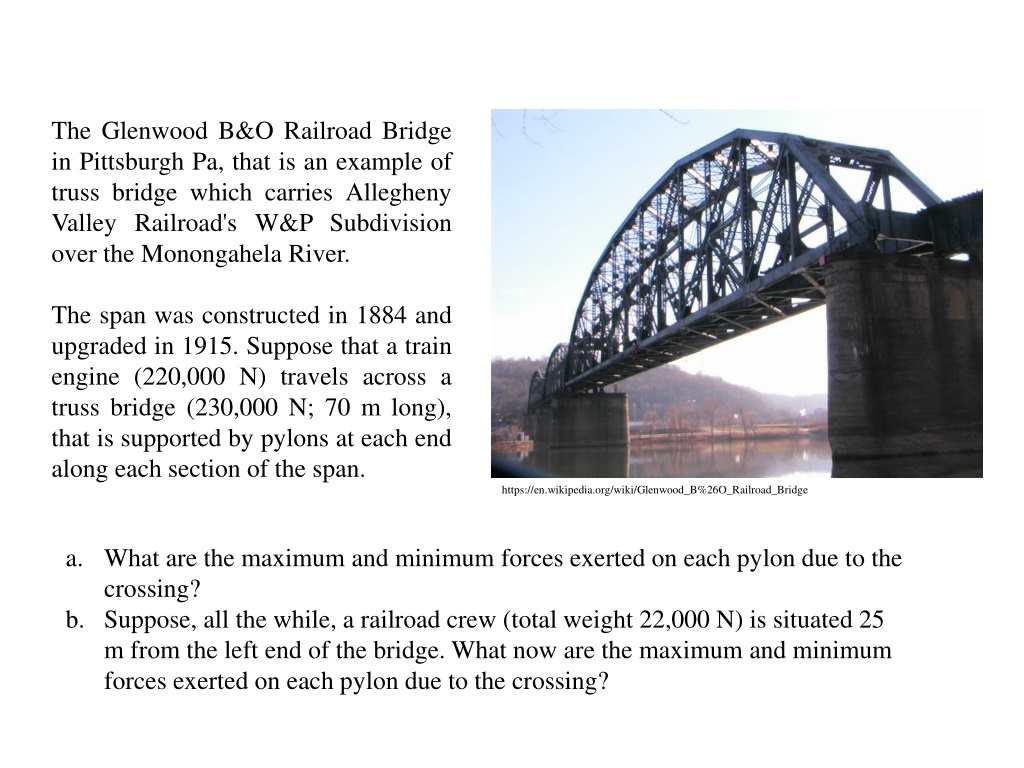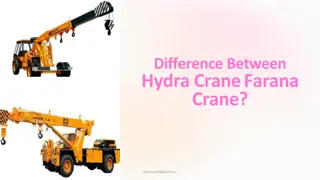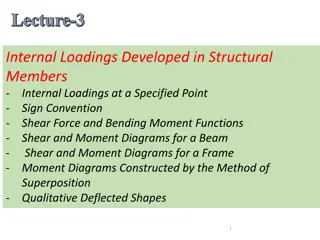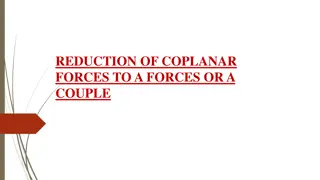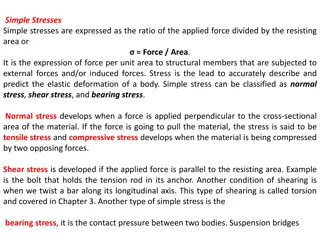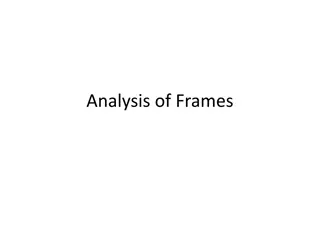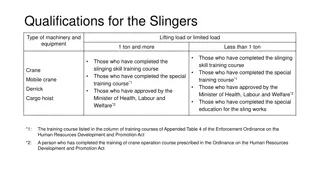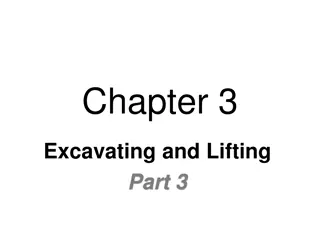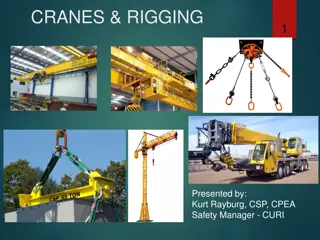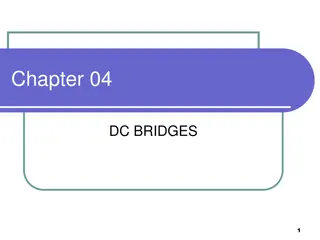Understanding Structural Forces in Bridges and Cranes
Truss bridge and tower crane scenarios are explored, involving calculations of forces on pylons, balance points, torque analysis, and load lifting capacities. The content also delves into the mechanics of a ladder against a wall and the stresses on the lower back during bending and lifting activities.
Download Presentation

Please find below an Image/Link to download the presentation.
The content on the website is provided AS IS for your information and personal use only. It may not be sold, licensed, or shared on other websites without obtaining consent from the author. Download presentation by click this link. If you encounter any issues during the download, it is possible that the publisher has removed the file from their server.
E N D
Presentation Transcript
The Glenwood B&O Railroad Bridge in Pittsburgh Pa, that is an example of truss bridge which carries Allegheny Valley Railroad's W&P Subdivision over the Monongahela River. The span was constructed in 1884 and upgraded in 1915. Suppose that a train engine (220,000 N) travels across a truss bridge (230,000 N; 70 m long), that is supported by pylons at each end along each section of the span. https://en.wikipedia.org/wiki/Glenwood_B%26O_Railroad_Bridge a. What are the maximum and minimum forces exerted on each pylon due to the crossing? b. Suppose, all the while, a railroad crew (total weight 22,000 N) is situated 25 m from the left end of the bridge. What now are the maximum and minimum forces exerted on each pylon due to the crossing?
A 5.0 m long ladder with mass mL = 100 kg is laid against a frictionless wall at an angle with respect to the floor as shown below. Suppose that the coefficient of friction between the floor and ladder is = 0.09 and that a painter of mass mp = 60 kg has climbed up the ladder and has made it to a point 70% of the length of the ladder when the ladder begins to slip. a. From a free-body diagram, determine expressions for the normal forces due to the wall and the floor. a. Write an expression for the sum of the torques about the origin O (shown above) in terms of the angle and evaluate your expressions for and then the net force on the bottom of the ladder. (Hints: You will need the fact that sin(90 - ) = cos and for counter-clockwise rotations choose positive for the direction of the torque.)
Tower cranes are used to construct high-rise buildings. A load is attached to the hook and the trolley moves out along the jib to bring the load to a desired location. Counterweights on the counter jib are moved and used to balance the load so that the crane does not fall. Suppose that at the very left end of the counter jib there is a large 120 ton counterweight and this initial position of the counterweight is at a distance 30m from the center of the crane s tower. The jib, on the right has a length of 100m (measured from the crane s tower) and supports the hook that is used to lift the loads. Suppose the mass of the jib is 25 tons and the counter-jib is 75 tons. https://www.gruasyaparejos.com/en/tower-crane/tower-crane-parts/ a. Where should the crane operator position the movable counterweight to achieve a perfect balance of the crane? Assume that the hook is located two-thirds of the way out along the jib end and that it is lifting a 19 ton load. In addition take the pivot to be located at the crane operator s cab, let the hook have mass 0.5 tons, and choose counter-clockwise as the positive direction for the torque. Suppose that the counterweight were moved to the far left end of the counter jib. What is the maximum weight that the crane could lift on the far right end in this situation? The load is lifted by a cable that is hoisted by a motor located near the operator s cab. The motor s shaft is connected to the pulley (of weight Fw,p = 5 tons and diameter dp = 6m) to which the cable is attached. What torque has to be produced to lift the load in part bat constant speed? b. c.
As high as eighty percent of the population at one time or another will suffer from some form of lower back pain, especially during bending and lifting activities. The stresses, which the mussels apply to the disks located between each of the vertebrae, can be very large and these stresses can, along with degeneration of the structure of the disks produce pain, muscle spasm, and immobilization of the lower back. We ll specifically look at the lumbo-sacral intersection of the spine as the point at which we bend, to say pick something up when you keep your legs straight. We ll look at a specific case of just bending over with your arms hanging vertically to determine how large the reaction force on the lumbo-sacral disk can be in this case in terms of your weight. lumbro-sacral intersection Figure 1: Views of the human spine. Figure from Clinically Oriented Anatomy, by Morre & Dalley.
The Major Muscle Groups of the Human Back https://www.studyblue.com/notes/note/n/huaty-1223-study-guide-2011-12-rooney/deck/9730325
The Major Muscle Groups and Vertebral Column of the Human Back Posterior X-ray image of the lower spinal column on the left and a sagittal MRI of the lumbar spine below. http://medicine.missouri.edu/radiology/iCases/MSK/case1/case01.ht m http://w-radiology.com/ct-lumbar-spine.php https://www.studyblue.com/notes/note/n/huaty-1223-study-guide-2011-12-rooney/deck/9730325
a. What are the expressions for the sum of the forces in the vertical and horizontal directions? a. What is the expression for the sum of the torques about the lumbo-sacral disk? Assume that you have bent over so that your spinal column makes an angle with respect to the horizontal and are not moving. Cartoon illustration of the problem. Drawing from Physics with Illustrative Examples from Medicine and Biology, by Benedek & Villars. b. What is the magnitude of the force Fe exerted by the erector spinae muscles at a point two-thirds the length of your spine? Assume that = 300, = 120, FW,torso = 0.4FW and FW,arms = 0.2FW. Fe FR FW,arms c. What is the magnitude and direction of the reaction force FR at the base of the spine, or at the lumbo-sacral joint, in terms of your weight FW? Lumbo-sacral disk FW,torso Stick figure drawing of your spinal column showing the various forces that act.
The Union College Physics Department has decided to hang a sign outside of the department office so that all passers by can read how much fun physics can be. Suppose that the sign (with a mass ms = 220kg) is suspended by a massless wire from a uniform boom (mb = 110kg) and that the boom makes an angle of 300 respect to the vertical as shown below. The boom is attached to the wall by a horizontal light support wire. a. How far from the pivot is the horizontal wire attached to the boom? Suppose that the cable snaps and the system rotates about the pivot. b. What is the initial angular acceleration of the system? Physics is Phun! pivot FR
Sometimes in life things dont seem to go your way. Heres a classic example of things not going your way. Suppose you re standing near the counter at home and that you just made yourself toast. You decide to butter it (or put jam/jelly on it) and then you drop it accidentally on the edge of the counter. The toast falls and lands buttered side down . Why? https://www.amazon.com/Toast-Lands-Jelly-Side-Down- Demonstrations/dp/B010WEMY7A https://www.amazon.com/Toast-Always-Lands-Butter-Side/dp/1845291247
